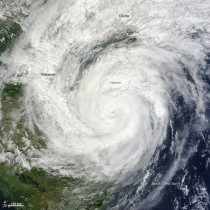A paper published today in Geophysical Research Letters notes
“Though there is speculation to associate global warming with [the intensity of Haiyan], existing research indicate that we have been in a warming hiatus period, with the hiatus attributed to the La Nina-like multi-decadal phenomenon. It is thus intriguing to understand why Haiyan can occur during hiatus.”
Although typhoon Haiyan was, according to the Philippine Atmospheric Administration, the seventh strongest storm to hit the Philippines, Typhoon Sening, which hit during the low-CO2 1970’s ice age scare, was the strongest storm recorded.
According to the paper, the “La Nina-like multi-decadal” “hiatus” “suggests that as the western Pacific manifestation of the La Nina-like phenomenon is to pile up warm subsurface water to the west, the western North Pacific experienced evident subsurface warming and created a very favorable ocean pre-condition for Haiyan.”

However, multi-decadal La Nina-like and E...Warming (also known as the cold PDO):
I. - I. Lin*, Iam-Fei Pun and Chun-Chi Lien
With the extra-ordinary intensity of 170 kts, super-typhoon Haiyan devastated the Philippines in November 2013. This intensity is among the highest ever observed for tropical cyclones (TCs) globally, 35 kts well above the threshold of the existing highest category of 5. Though there is speculation to associate global warming with such intensity, existing research indicate that we have been in a warming hiatus period, with the hiatus attributed to the La Nina-like multi-decadal phenomenon. It is thus intriguing to understand why Haiyan can occur during hiatus. It is suggested that as the western Pacific manifestation of the La Nina-like phenomenon is to pile up warm subsurface water to the west, the western North Pacific experienced evident subsurface warming and created a very favorable ocean pre-condition for Haiyan. Together with its fast traveling speed, the air-sea flux supply was 158% as compared to normal for intensification.”

----------
See this rare debate at University of Northern Iowa “Climate Instability: Interpretations of Scientific Evidence” Dr. Jerry Schnoor of the University of Iowa presented the case for the theory of man-made warming and Steve Goreham argued the case for climate change driven by natural causes.




